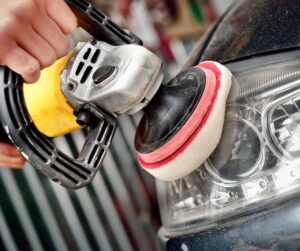Transform Your Vehicle's Safety with Expert Headlight Restoration
Effective headlight restoration plays a crucial role in enhancing the performance of your vehicle's lighting system, ensuring that your headlights are not just functional but also optimized for safety and visibility.
It's vital to understand that deteriorated headlights compromise not just your vehicle's safety but also violate traffic regulations, potentially leading to legal repercussions.
Vehicles equipped with worn-out headlights will not meet the rigorous standards required for obtaining a roadworthy certificate.
This situation makes the vehicle illegal to operate on public roads, thus increasing the risk of accidents for both the driver and other motorists.
Moreover, cloudy or yellowed headlights can drastically reduce your visibility while driving at night, with studies indicating a reduction of up to 75% in clarity.
While replacing your headlights entirely can be a significant expense, it's often unnecessary when a restoration can effectively restore their clarity.
You could attempt a DIY restoration, but it is highly recommended to seek the expertise of a professional car detailer to achieve the best possible results.
Recognizing the Vital Role of Headlight Restoration in Vehicle Maintenance
Identifying the Root Causes of Headlight Discoloration and Deterioration
As vehicles age, the plastic headlight lenses can start to degrade due to various environmental factors, including abrasion from road debris and prolonged exposure to harmful UV rays.
This gradual deterioration leads to a yellowish, opaque look that severely diminishes the effectiveness of your headlights if not addressed in a timely manner.
In regions such as Brisbane, the humid tropical climate can exacerbate these issues, causing significant damage to the porous materials used in headlight lenses.
A common misconception is that the damage occurs internally; however, the degradation primarily happens on the exterior surfaces of the lenses.
Comparing Different Headlight Lens Materials: The Battle of Plastic vs. Glass
Exploring the Features and Limitations of Glass Headlights
Although glass headlight lenses do not experience the same level of discoloration as their plastic counterparts, they are still vulnerable to chipping and cracking, which may necessitate replacement.
In fact, glass headlights were largely phased out in the 1990s as manufacturers shifted to polycarbonate lenses, which have since become the industry standard.
Polycarbonate Headlights: Strength with Certain Vulnerabilities
Currently, nearly all vehicles are equipped with headlights made from polycarbonate, a tough yet porous type of plastic that is highly susceptible to discoloration when exposed to ultraviolet rays.
This fading effect is commonly referred to as oxidation, a process that also impacts the paintwork of our vehicles.
To mitigate oxidation, manufacturers typically apply a protective hard coating over the lens, which effectively seals and protects the plastic from fading.
However, with time, this factory-applied coating can degrade, necessitating its removal and replacement with a new, high-quality protective layer.
Discover the Significant Benefits of Professional Headlight Restoration
Modern headlights are predominantly crafted from polycarbonate plastic, which, while durable, remains vulnerable to oxidation caused by UV exposure.
In warmer climates like Brisbane, the need for timely headlight restoration becomes increasingly significant compared to cooler regions.
Here are several compelling advantages of restoring your headlights promptly when you notice any yellowing or dimming:
- Improved Road Safety: Cloudy headlights can significantly hinder visibility, creating a dangerous scenario when driving at night.
- Maintaining Vehicle Value: A vehicle with clear, functional headlights retains its market value; neglecting this aspect can lead to depreciation.
- Cost-Effective Solution: Restoring existing headlights is a more economical solution than the high costs associated with purchasing new units.
- Enhanced Aesthetic Appeal: Restoring your headlights can greatly enhance the overall look of your vehicle, giving it a well-maintained appearance.
- Increased Visibility: A successful headlight restoration can dramatically improve nighttime visibility, contributing to safer driving conditions.

Vital Considerations When Selecting a Headlight Restoration Service
Many economical headlight restoration services merely focus on removing the degraded factory protective clear coat, which can lead to further issues.
Such processes leave the plastic lens unprotected, resulting in rapid discoloration and the formation of tiny cracks, a condition known as ‘crazing,' within a few months.
Employing such low-quality restoration techniques removes the necessary protection against UV damage, which is essential for maintaining headlight clarity.
The protective coating is critical as it shields the headlight from various environmental harms.
Utilizing machine buffing as a quick fix can ultimately cause irreversible damage to the lens, leaving it vulnerable to future degradation.
Prioritize Quality in Your Headlight Restoration Process
A comprehensive headlight restoration process entails the complete removal of the old, deteriorated factory clear coat.
The headlights undergo a gentle polishing process, and the surrounding areas of the vehicle are masked off to prevent any overspray during the application.
Following this, a new protective coating is applied, which cures to form a robust clear coat that bonds seamlessly with the polycarbonate material.
This results in a long-lasting, chemical-resistant layer that remains crystal clear and does not yellow, offering durability comparable to brand-new headlights.
Comprehensive Step-by-Step Guide for Effective Headlight Restoration
There are two main approaches for restoring your headlights: opting for a DIY method or hiring a professional car detailer.
If you choose to take the DIY route, make sure to invest in a complete headlight restoration kit designed for your specific needs.
While some outdated methods suggest using toothpaste as a cleaning agent, this approach is largely ineffective for modern headlight materials.
Although toothpaste can offer slight abrasiveness, it risks damaging the essential sealant required to protect your headlights effectively.
If the protective coating is compromised, it must be entirely stripped away and replaced with a new coating for optimal results.
Rather than risking additional damage, it's wise to consult a professional who can ensure the job is done correctly.
However, if you decide to proceed with the DIY approach, here are the steps you should follow:
Start by obtaining a complete headlight restoration kit.
- Thoroughly clean your vehicle.
- Carefully tape around the edges of your headlights to protect the surrounding paint.
- Utilize sandpaper to eliminate any cloudiness from the lens surface, achieving a smoother finish.
- Apply the provided polish to achieve clarity and shine on the lens.
- Complete the process with any final coatings as outlined in the instructions.
Take the Next Step for Enhanced Safety with Clearer Headlights
Ensure your vehicle remains compliant with road safety standards and enhances your nighttime visibility by having a professional assess and restore your headlights.
If you observe your headlights becoming dim, foggy, or exhibiting a yellowish tint, it’s essential to arrange a professional detailing and headlight restoration service promptly.
By integrating these services, you can revitalize your vehicle, achieving not only polished paintwork but also bright, clear headlights that enhance driving safety.
As your trusted local experts in headlight restoration and repair, we encourage you to reach out for more information about our car detailing Brisbane services.
The Article Headlight Restoration: Understanding the Process and Benefits Was Found On https://limitsofstrategy.com

Comments are closed